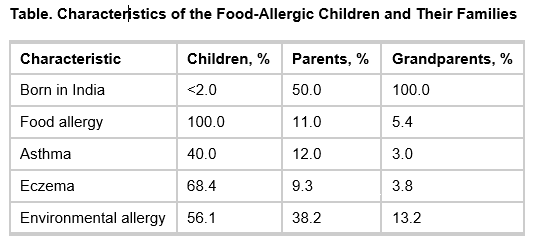
As ethnic populations migrate to different countries, children of these migrants develop the same allergies as most other children. However, children are developing allergies to foods that we have not seen in the past, especially in some ethnic populations.
At the American College of Allergy, Asthma & Immunology 2015 Annual Scientific Meeting, results of an Asian Indian Food Allergy Survey were presented. The survey was of Asian Indian children living in the United States. The list of allergies in Asian Indian children included the usual top allergens that are normally seen in children. Surprisingly, there has been an increase in allergies to some more unusual foods.
The respondents to the survey reported that 67.5% of the allergies were diagnosed by a doctor, 70.2% were diagnosed with blood or skin tests, and 29.8% were diagnosed with a food challenge. Compared to what allergists normally see, there were a lot of fruit and vegetable allergies, more common than seafood allergies, which is unusual.
Tree nut allergy was seen in 59% of the children in the Indian group, possibly due to the fact that there are a lot of nuts in Indian cooking. Some of the Asian Indian children were allergic to besan, a chickpea flour, capsicum, and lentils. Other allergens considered unique were avocado, banana, beef, bulgur wheat, coconut, corn, eggplant, food dye, garlic, ginger, green peas, jalapeno peppers, kiwi, melon, rice, and tomato.
The allergies considered ‘unique’ by these investigators, such as avocado and banana were not considered to be so unusual by other allergists. The newer foods like ginger and the jalapeno pepper are more surprising. People just weren’t exposed to these foods previously, and with migration they are expose to them more often.
The question is whether the increase in allergies is migration related, or just a reflection of a world-wide increase in allergies.

The table above is interesting as it shows the incidence of allergy and allergy related disorders over the generations and with migration to the United States. Grandparents born in India had the lowest incidence of allergy and allergy related disorders. The children born outside of India had a very high incidence of allergy and food related disorders.
As one allergist noted, “The big thing that’s happening now is that people are looking for ‘natural’ food and new food.” Hence we are beginning to see allergies to quinoa and lentils as well as to flaxseed.
The question is why are these allergies to foods, that have not been a problem previously, are all of a sudden beginning to become a problem? This is a concern as most common food allergy tests only include the main foods that have been a problem in the past. A patient comes in suspecting that they have a food related allergy. Are tested by the allergist and nothing comes up. Food allergy test panels often do not include these unusual foods.
Regardless of what a person may be reacting to, the underlying cause is the same. The immune system has been primed to over react to particular food protein antigens. There is a tendency for these individuals to become hypersensitive to food proteins. So, we identify the foods that are an issue and remove them from the diet. However, we have not done anything to change how the immune system is sensitized to food proteins. Most commonly the leakage of partially digested food proteins through the gut wall (“leaky gut”) where the immune system mounts an allergic response. What is causing the leaky gut? There are many possible causes, however in our Western diet gluten is a big suspect. Gluten activates a protein called zonulin which disrupts the tight junctions between the intestinal cells making the gut barrier “leaky” to food proteins. Larger food proteins are able to permeate through the intestinal barrier to activate the immune system.
Unless the compromised intestinal barrier is repaired the tendency to develop new food allergies remains, as well as setting up an inflammatory state within the body. Restoring the intestinal barrier requires a comprehensive digestive repair program. This involves removing the irritants or pathogens that are causing the damage to the intestinal wall. Also, adding in nutrients that help repair the damage done, as well as specific probiotics to decrease intestinal inflammation, support the bowel flora and modulate the immune system away from an overactive allergic immune response.
Source: You’re Allergic to What? New Food Allergies Emerging. Medscape. Nov 12, 2015.



